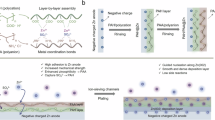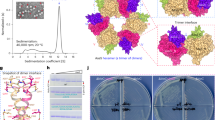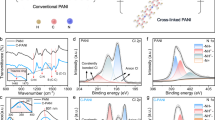Abstract
An enzyme electrode was prepared by covalent immobilization of acid phosphatase (ACP) on a polyaniline/poly(acrylic acid) composite film (PANI/PAA film) deposited on an Au electrode and used as the anode of a fuel cell driven with L-ascorbic acid 2-phosphate (ASA2P). Biochemical and electrochemical properties of the enzyme electrode were compared with those of the one fabricated without the PANI/PAA film by enzyme immobilization on an Au electrode bearing a self-assembled monolayer formed with 3-mercaptopropionic acid. The former electrode was found superior to the latter in the quantity of immobilized ACP, the function to scavenge ascorbic acid (ASA), resulting from dephosphorylation of ASA2P by ACP and the electrochemical ability to oxidize ASA. The ASA2P fuel cells were constructed by use of the enzyme electrodes as anodes. The fuel cell using the enzyme electrode fabricated with the PANI/PAA film gave a maximum power output of 6.0 μW cm−2-anode, which was 70 times as large as that obtained with the cell using the electrode fabricated without the PANI/PAA film, and thus the power output was dependent on the performance of the enzyme electrode.
Similar content being viewed by others
Log in or create a free account to read this content
Gain free access to this article, as well as selected content from this journal and more on nature.com
or
References
Kamarudin, S. K., Achmad, F. & Daud, W. R. W. Overview on the application of direct methanol fuel cell (DMFC) for portable electronic devices. Int. J. Hydrog. Energy 34, 6902–6916 (2009).
Fujiwara, N., Yamazaki, S., Siroma, Z., Ioroi, T. & Yasuda, K. Direct oxidation of L-ascorbic acid on a carbon black electrode in acidic media and polymer electrolyte fuel cells. Electrochem. Commun. 8, 720–724 (2006).
Fujiwara, N., Yamazaki, S., Siroma, Z., Ioroi, T. & Yasuda, K. L-Ascorbic acid as an alternative fuel for direct oxidation fuel cells. J. Power Sources 167, 32–38 (2007).
Fujiwara, N., Yamazaki, S. & Yasuda, K. Research and development on direct polymer electrolyte fuel cells. J. Jpn. Pet. Inst. 54, 237–247 (2011).
Wu, J., Xiao, Z. Y., Ying, Y. B. & Chan, P. C. H. Development of a miniature silicon wafer fuel cell using L-ascorbic acid as fuel. J. Zhejiang. Univ.-SCI A 9, 955–960 (2008).
Peterson, R. W. & Walton, J. H. The autoxidation of ascorbic acid. J. Am. Chem. Soc. 65, 1212–1217 (1943).
Kuwahara, T., Homma, T., Kondo, M. & Shimomura, M. A novel system combining biocatalytic dephosphorylation of L-ascorbic acid 2-phosphate and electrochemical oxidation of resulting ascorbic acid. Biosens. Bioelectron 26, 3382–3385 (2011).
Austria, R., Semenzato, A. & Bettero, A. Stability of vitamin C derivatives in solution and topical formulations. J. Pharm. Biomed. Anal. 15, 795–801 (1997).
Kuwahara, T., Oshima, K., Shimomura, M. & Miyauchi, S. Immobilization of glucose oxidase and electron-mediating groups on the film of 3-methylthiophene/thiophene-3-acetic acid copolymer and its application to reagentless sensing of glucose. Polymer 36, 8091–8097 (2005).
Kuwahara, T., Homma, T., Kondo, M. & Shimomura, M. Fabrication of enzyme electrodes with a polythiophene derivative and application of them to a glucose fuel cell. Synth. Me.t 159, 1859–1864 (2009).
Liu, C., Kuwahara, T., Yamazaki, R. & Shimomura, M. Covalent immobilization of glucose oxidase on films prepared by electrochemical copolymerization of 3-methylthiophene and thiophene-3-acetic acid for amperometric sensing of glucose: effects of polymerization conditions on sensing properties. Eur. Polym. J. 43, 3264–3276 (2007).
Miyake, T., Yoshino, S., Hata, K. & Nishizawa, M. Self-regulating enzyme-nanotube ensemble films and their application as flexible electrodes for biofuel cells. J. Am. Chem. Soc. 133, 5129–5134 (2011).
Homma, T., Kondo, M., Kuwahara, T. & Shimomura, M. Electrochemical polymerization of aniline in the presence of poly(acrylic acid) and characterization of the resulting films. Polymer 53, 223–228 (2012).
Shimomura, M., Kikuchi, H., Yamauchi, T. & Miyauchi, S. Covalent immobilization of glucose oxidase on magnetite particles via graft polymerization of acrylic acid. J. Macromol. Sci. Part A-Pure Appl. Chem 33, 1687–1697 (1996).
Shimomura, M., Miyata, R., Kuwahara, T., Oshima, K. & Miyauchi, S. Immobilization of glucose oxidase on the films prepared by electrochemical copolymerization of pyrrole and 1-(2-carboxyethyl)pyrrole for glucose sensing. Eur. Polym. J. 43, 388–394 (2007).
Shimomura, M., Ohta, M., Sugiyama, N., Oshima, K., Yamauchi, T. & Miyauchi, S. Properties of α-chymotrypsin covalently immobilized on poly(acrylic acid)-grafted magnetite particles. Polym. J. 31, 274–278 (1999).
Yano, J., Hirayama, H., Harima, Y. & Kitani, A. Electrochemical and UV-visible spectroscopic study on direct oxidation of ascorbic acid on polyaniline for fuel cells. J. Electrochem. Soc. 157, B506–B511 (2010).
Ambrosi, A., Morrin, A., Smyth, M. R. & Killard, A. J. The application of conducting polymer nanoparticle electrodes to the sensing of ascorbic acid. Anal. Chim. Acta 609, 37–43 (2008).
Mondal, S. K., Raman, R. K., Shukla, A. K. & Munichandraiah, N. Electrooxidation of ascorbic acid on polyaniline and its implications to fuel cells. J. Power Sources 145, 16–20 (2005).
Takahashi, T. Determination of inorganic phosphorus and phosphocreatine, and actions of phosphoamidase and creatine phosphokinase in boar spermatozoa. SEIKAGAKU 26, 690–698 (1955).
Acknowledgements
This work was partly supported by a Grant-in-Aid for Scientific Research (B) (no. 23360302) from the Ministry of Education, Culture, Sport, Science and Technology of Japan, which is gratefully acknowledged.
Author information
Authors and Affiliations
Corresponding author
Rights and permissions
About this article
Cite this article
Homma, T., Kondo, M., Kuwahara, T. et al. Immobilization of acid phosphatase on a polyaniline/poly(acrylic acid) composite film for use as the anode of a fuel cell driven with L-ascorbic acid 2-phosphate. Polym J 44, 1117–1122 (2012). https://doi.org/10.1038/pj.2012.81
Received:
Revised:
Accepted:
Published:
Issue date:
DOI: https://doi.org/10.1038/pj.2012.81



